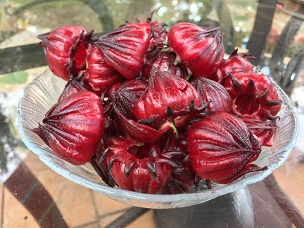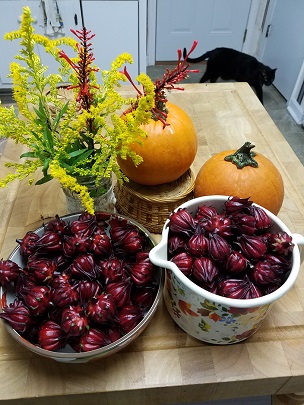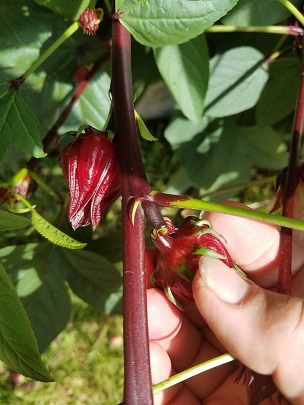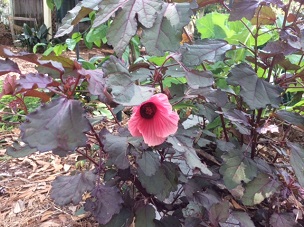Roselle and Other
Edible Hibiscus
From Community blogs, Leon
County,
Institute of Food
and Agricultural Sciences, University of Florida
by Janis
Piotrowski

Roselle can
be used fresh or dried in many dishes, including jams, sauces, and teas
Trevor Hylton, a Leon County UF/IFAS Extension Agent who hails from
Jamaica, had been telling the VegHeadz volunteers in the demonstration
vegetable garden at the Extension Office on Paul Russell Road, about
Roselle (Hibiscus
sabdariffa). It grows wild in his home country, and
is also widely cultivated there. He planted one in the VegHeadz garden
a few years ago, but we pretty much ignored it since it was not
something we were familiar with, and didn’t know what to do with it.
That
is often the case with edibles that are commonplace in another area of
the country, or in other parts of the world. Through experimenting,
we’ve learned there are many of these unfamiliar plants we can grow
here. They often fill in the gaps in growing seasons to provide a
year-round diet of healthy and interesting foods.

Roselle
calyxes are a beautiful shade of deep red
When
Roselle seeds were included in a bunch of perennial vegetables obtained
from the Edible Plant Project in Gainesville
(http://edibleplantproject.org) for the demonstration garden, we
eventually decided to try planting some. An interesting plant emerged,
growing fast, and then sprawling over a considerable space in the
garden. It seemed to have little to recommend, except attractive green
leaves with red stems, until late in the summer when it began to bloom.
Simple pale yellow flowers with dark centers emerged, similar to others
in the Malvaceae or mallow family such as okra, hollyhock, or cotton.
What
really got our attention were the fleshy dark red bulbs developing
below the blooms, the calyxes or calyces, which were attractive and
intriguing. Then we learned most parts of the plant are edible. Roselle
is sometimes called Florida Cranberry, but it does not have the bitter
undertones of cranberries, and there is a hint of raspberry in the
flavor. The leaves have a tart rhubarb-like flavor and are sometimes
cooked as greens or used in salads.
In our area, Roselle is an
annual, which we have planted each year from seed. We start it in pots
about six weeks before the last frost, and plant it in the ground in
April or May. It can also be grown from cuttings. It will grow in full
sun to part shade, in almost any soil. It benefits from the addition of
compost and organic matter, and prefers evenly moist soil, although it
is somewhat drought tolerant. Fertilizer should not be necessary. It
may reach six to eight feet tall and equally as wide. It will begin to
bloom when the days start to shorten and will continue until the first
frost.

Picking a
Roselle calyx
The
calyxes should be harvested no more than a day or two after the blooms
drop, as they will become fibrous as they mature. One variety of
Roselle is used like hemp to make burlap.
Inside each calyx is a
marble-sized seed capsule that should be removed before using the
flesh. Save some of the capsules, which when dried will open and reveal
the seeds, which can be saved for planting the following year. The
calyxes can be used fresh or dried for later use in sauces and jams.
They contain pectin, so additional pectin is not necessary when making
jam. Red Zinger tea is made from dried Roselle. The fresh or dried
flesh can be used for teas and other refreshing drinks. Cook with sugar
like cranberries to make a sauce for use on ice cream and other
desserts, on French toast, or as a side to meats. Place a little of the
sauce at the bottom of a wine glass. Add wine or champagne for a
special occasion drink. Roselle cheesecake is a show-stopper. For more
information about removing the seeds, and a recipe or two, see the
VegHeadz blog below.
Fun in the Garden -
Roselle (How to Remove the Seed Capsule), VegHeadz Blog

Cranberry
hibiscus is an edible perennial, and is often used in teas or
even salads and stir fries
Roselle should not be confused with Cranberry Hibiscus (Hibiscus acetosella),
a perennial which is also edible. Its maple-shaped leaves are a bold
purplish bronze, which pop as a border or specimen plant in the
landscape. It may die back in the winter, but unless there is a very
hard freeze, will return in the spring. Grow in full sun to light shade
in well-drained soil. Prune to obtain a full bushy plant. The flowers
and leaves are used to make tea, with the flowers making a sweeter tea,
and the leaves are more tart or astringent. Young, tender leaves can be
used in salads and stir fries, and the flower petals can be added to
anything which would benefit from a tart citrusy flavor. It does not
have a fleshy calyx like Roselle.
A third type of edible hibiscus, Chinese Hibiscus (Hibiscus rosa-sinensis),
has much larger flowers in a wide range of colors. Originating in Asia,
and grown widely there, it is rated for growing zones 9 and 10, and is
probably a tender perennial in our area (Zone 8b), where it might best
be grown in a large container.
All of these hibiscus are
attractive to hummingbirds and butterflies. Even if they weren’t good
to eat, they would be worth having in your yard. For more information
on growing and using Roselle, see
http://gardeningsolutions.ifas.ufl.edu/plants/edibles/vegetables/roselle.html.
Janis
Piotrowski is a Master Gardener volunteer with the UF/IFAS Leon
County Extension. She hosts blogs about gardening and sustainable
living in North Florida at www.northfloridavegheadz.blogspot.com.
Back to
Hibiscus
Page
Fun in the Garden -
Roselle (How to Remove the Seed Capsule) Page
|
|
Bibliography
Piotrowski, Janis. "Roselle and Other Edible Hibiscus." June 9, 2017, Community blogs, blogs.tallahassee.com/community/2017/06/07/roselle-and-other-edible-hibiscus/.
Accessed 2 July 2019.
Photographs
Fig. 1 Piotrowski, Janis. "Roselle can be used
fresh." June 9, 2017, Community blogs, blogs.tallahassee.com/community/2017/06/07/roselle-and-other-edible-hibiscus/.
Accessed 2 July 2019.
Fig. 2 Lyons, Becky. "Roselle calyxes are a
beautiful shade of deep red." June 9, 2017, Community
blogs, blogs.tallahassee.com/community/2017/06/07/roselle-and-other-edible-hibiscus/.
Accessed 2 July 2019.
Fig. 3 Lyons, Becky. "Picking a Roselle
calyx." June 9, 2017, Community
blogs, blogs.tallahassee.com/community/2017/06/07/roselle-and-other-edible-hibiscus/.
Accessed 2 July 2019.
Fig. 4 Maligne-Lynch, Regine.
"Cranberry hibiscus is an edible perennial." June 9, 2017, Community
blogs, blogs.tallahassee.com/community/2017/06/07/roselle-and-other-edible-hibiscus/.
Accessed 2 July 2019.
Published 24 Sept. 2019 KJ
|



